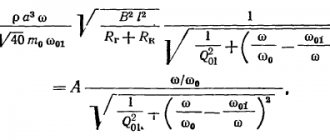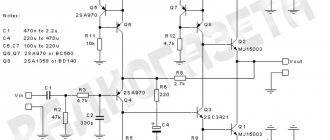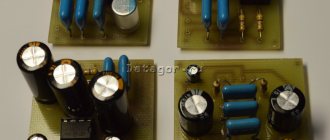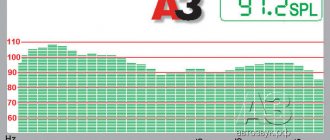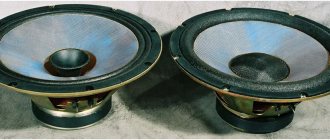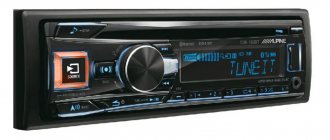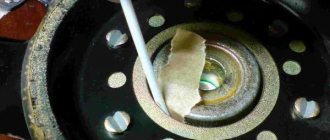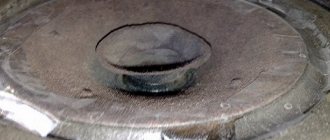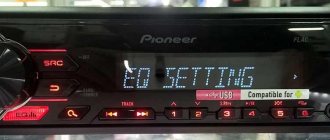The mid-range speaker, or otherwise called mid-range, reproduces frequencies in the range from 250-350 Hz to 6000-7000 Hz. The sensitivity of such devices varies from 89 to 93 dB. It is believed that this particular speaker is the most important for reproducing sounds, since most of the waves are in the mid range. High and low frequencies only add color and depth to the sound, while the mid-range speaker takes on all the load.
Since it is the midrange speakers that bear the main load, they must be present in any speaker system. Such dynamic emitters will make it possible to distinguish a piano from a violin, a male voice from a female one, which makes its significance undeniable. In this regard, you should study the characteristics of the device in more detail and learn how to choose it correctly.
Types of midrange speakers
There is a division of mid-range speakers depending on the shape of the radiating surface. They are:
- with dome diaphragm;
- with cone diffuser.
Dome diffusers reduce the amount of sound distortion, and their radiation pattern is less dependent on frequency. True, such devices have a slightly reduced range of converted frequencies, especially at the low end. It usually starts at 800-1000 Hz.
Speakers with cone heads also have disadvantages. As a rule, the dimensions of such a device are many times larger, which means the speaker body will be quite voluminous. It is believed that the optimal value for the size of the conical head will be 10 cm, so this parameter should be adhered to.
Head Damping Methods
For amateur conditions, the following damping methods can be recommended.
1. Bypassing the midrange head with a high-quality series oscillatory circuit tuned to the resonant frequency of the head installed in the loudspeaker. At the resonant frequency, such a circuit plays the role of a jumper that short-circuits the head terminals. In the operating frequency band, its resistance increases so much that the shunting effect can be ignored. Damping using a circuit is effective only when using a highly efficient midrange driver with a low quality factor Qe. In other words, only at Re
2. Acoustic damping of the head using an acoustic resistance panel (PAS) (see article by N. Molodoy, V. Shorov and I. Khraban “Acoustic damping of loudspeakers” in “Radio” 1969, No. 4, pp. 27, 28). This technical solution, protected by USSR copyright certificate No. 577699, makes it possible to reduce the acoustic quality factor Qa of the loudspeaker head several times and make it comparable and even lower than the electrical quality factor Qe.
Damping the heads with sound-absorbing material (for example, cotton wool) is less effective and helps to increase their resonant frequency.
Midrange speaker design
The design of a speaker specializing in mid-frequencies is not particularly different from other dynamic drivers. The elements include:
- corrugated suspension;
- diffuser;
- cap;
- centering washer;
- voice coil;
- magnetic system.
When producing midrange speakers, especially for high-power speaker systems, the most care is required. This is due to the fact that such emitters operate in a range that is more visible to humans. Since these sound waves are easily perceived by the ear, any distortion will be more obvious. This means that in order for the listener to enjoy the music, it is necessary that the mid-frequency speakers produce clear sound.
When designing such devices, they adhere to the same principles as when creating low-frequency dynamic radiators, but there are also special nuances that apply only to this type of speaker. So, as noted earlier, the radiating element can take the form of domes or curved horns in the form of a cone. Cone-shaped cones are used to reproduce frequencies from 200 Hz to 5 kHz. The size of such speakers is approximately 12.5-20 cm. However, the use of speakers of this configuration is limited due to the narrow directionality.
Dome diffusers have a diameter of 4 to 8 cm. Midrange speakers with this design feature have better directionality, but are more aimed at reproducing high frequencies. Their range varies from 600 Hz to 8 kHz. The shape of a dome-type diffuser is directly related to the material from which it is made. Most diffusers are made from soft or hard materials. For soft ones use:
- impregnated fabrics;
- cellulose;
- synthetic films and others.
Rigid diffusers are made from:
- titanium;
- aluminum;
- beryllium foil;
- high modulus alloys, often with boron, etc.
The difference in material affects the quality of the sound produced. Mid-range drivers with a soft-material cone often deliver natural, uncolored sound. This is especially noticeable at low input signal levels. At high levels in such diffusers, a loss of dynamic stability often occurs, making distortion more noticeable.
The mid-frequency speaker with a rigid diffuser allows you to reproduce sound waves in an extended range up to 12 kHz. This is achieved due to the piston nature of the vibrations, which makes the sound cleaner, and distortion manifests itself much less often.
Overtone and calculation of its duration
The free component of vibrations of the moving system of the head (or group of heads) gives rise to the so-called overtone, which is quite noticeable to the ear in poorly designed loudspeakers and deteriorates their sound quality. Since the emergence of a free component is a fundamentally irremovable phenomenon and constantly accompanies the transition process in any inertial system, the only possible way to combat the oversound is to reduce its duration. It is impossible to get rid of overtones using a bandpass filter, since due to the pulsed nature of the broadcast signal, it will always contain spectral components that excite the oscillatory system of the head at its resonance frequency.
The duration of the transition process is often taken to be the time interval Δt=tR, during which the amplitude of the free component of the oscillation decreases by 20 times, i.e., it becomes equal to 0.05 of its original (at t=0) value. Taking into account that 0.05 = e-3, guided by the law of change in the amplitude of free oscillations over time, we obtain the following formula for determining the duration of the transition process and overtones:
whence tп = ТsQt.
For example, let's find the duration of the overtone of the ZGD-42 head with a resonant frequency fs = 94 Hz and quality factor Qt = 0.7. The period of the resonant frequency of such a head is Ts = 1/fs, = 1/94 = 0.0106 = 10.6 ms. Overtone duration tп = ТsQt =10.6 * 0.7 =7.42 ms.
Reference literature, for example [2], recommends the following maximum permissible values for the duration of the overtone: 5 ms for low-frequency heads and 0.2 ms for mid-range heads.
Basic parameters when choosing mid-range speakers
Since the quality of acoustics depends on the speaker operating at medium frequencies, it is important that the sound is as clear as possible. This means that special attention should be paid to the choice of this particular device. Experts advise taking into account two main parameters:
- sensitivity;
- amplifier power.
The correct ratio of values (Sensitivity - Amplifier Power) will allow you to achieve better results. The table shows a comparison of parameters that provide optimal sound:
- 87 dB 200 W
- 88 dB 158 W
- 89 dB 126 W
- 90 dB 100 W
- 91 dB 79 W
- 92 dB 63 W
- 93 dB 50 W
A lot also depends on the size of the speakers. For mid-frequency emitters, the most optimal value is diameters exceeding 16 cm. It is also worth looking at what quality factor parameter is assigned to the device.
It is worth noting that most manufacturers place their maximum bet on this type of speakers, since they have a major impact on the sound quality of the entire speaker system. For this reason, it is important to understand that price and quality will be directly proportional, everything depends only on the purchasing capabilities of the listener.
Measuring the acoustic quality factor of the head
To experimentally determine the acoustic quality factor of the head, it is enough to find several characteristic points on the curve of the module of the complex resistance of the head versus frequency (Fig. 3), which allow us to judge the electrical resistance of the voice coil Re (see Fig. 1b), the electrical resistance of the head at the resonant frequency: Zp=Re+Ra resonant frequency fs, and frequencies f1 and f2, at which the head resistance is numerically equal to √(ZpRe)
Rice. 3. Curve of the dependence of the modulus of complex resistance of the head on frequency Fig. 4. Connection diagram for measuring speaker parameters.
For this purpose, a sound generator G1 with an output resistance of Rr = 50 Ohm, a tube voltmeter with a sufficiently large (at least 30 kOhm) input resistance and a resistor R1 with a resistance of 1–2 kOhm are connected to head B1 (Fig. 4).
When taking measurements, the head is suspended at a sufficient distance from reflective surfaces (walls, floors) or placed with the diffuser up on a stool standing in the middle of the room. The generator voltage Ug is set equal to 1 V (it should remain constant when the frequency changes) and, slowly adjusting it near the expected resonant frequency fs, the maximum deviation of the voltmeter needle is used to find the frequency value fs and voltage Uv = Uр.
Then, increasing the generator frequency, using the minimum voltmeter readings, find the frequency fmin and the corresponding voltage value: Uv = Umin.
After that. Having calculated the auxiliary voltage value U1 = √(UpUmin), find the frequencies f1 and f2 (the first is lower, and the second is higher than the resonant frequency fs), at which the voltmeter reading becomes equal to U1 and determine the acoustic quality factor Qa:
Qa = √(Up/Umin) *fs/(f2-f1)
In this formula, the multiplier √(Up/Umin) takes into account two factors: the influence of the head resistance Re on the dependence Z(f) and the frequency counting f1 and f2 not at the level of 0.707, but at the level U1 = √(Up/Umin). The use of such a “non-standard” reading level increases the accuracy of the method discussed here when measuring low-Q resonant systems.
The results of measurements of the acoustic quality factor of a number of loudspeaker heads are shown in the table. The heads 15GD-PA and 6GD-6 are mid-frequency, and all the others (from those included in the table) can be used as mid-frequency. You can see that the minimum value of the acoustic quality factor is 4, and the maximum reaches 19.
| Acoustic head | Quality factor, Qa |
| 0.5GD-37 | 5,9 |
| 1GD-40 | 12,3 |
| 1GD-39 | 10 |
| 1GD-50 | 10,8 |
| 2GD-40 | 11,5 |
| 3GD-42 | 8,5 |
| 6GD-6 | 6,3 |
| 10GD-30E | 6,1 |
| 10GD-34 | 3,9 |
| 15GD-11 A | 11,8 |
Thus, none of the heads listed in the table - when switched on through a midrange bandpass filter - can provide undistorted reproduction unless special measures are taken to reduce the acoustic quality factor.
Installing mid-range speakers in a car
Many car enthusiasts strive to equip their vehicle with a powerful sound system, so they purchase different types of speakers and build them in to provide surround sound. Any acoustic system cannot do without mid-frequency speakers, so the main focus is on them.
Such devices can be installed in the front part, in the area where the radio is located, as well as in the doors to provide side sound. It is not recommended to install midrange speakers in the rear compartment, as the sound will be worse. In addition, this is an ideal place for a subwoofer.
Subsonic
Subsonic is the same high pass filter (HPF) on sub amplifiers (often on monoblocks) - it cuts off infrasound. Set it to approximately 20 Hz.
Adjusting gain by ear (method 1)
Having a good sub link, do not use an equalizer and various bass enhancers, forget about bassboost on the amplifier - so before adjusting the gain, make sure that all this is turned off!
Set the control to minimum and play music that you usually listen to. Turn up the volume of the radio by 3/4 of the maximum; if you hear distortions in the sound of the subwoofer earlier, stop and turn down the volume a couple of notches. Go to the amplifier. Have an assistant slowly turn up the gain control until new distortion appears, and when you hear it, stop the rotation and turn it down by 10%.
READ How to make a table for a circular table with your own hands
How to make a choice and where to buy?
If you want to purchase a mid-range speaker, it is better to study the market on the Internet. There is a huge variety of models from manufacturers from all over the world, and the price category of the product will vary significantly. If in regular stores the assortment is rather low, and consultation is limited to the advice of the seller, then on the Internet you can read reviews about the product and, based on them, decide whether the device is suitable for specific purposes. True, the main advantage of buying through a store is the opportunity to listen to the speaker and evaluate the sound quality using the example of different compositions.
Application of ULF
Most often, ULF is used in equipment for reproducing sound, because in this field of technology it is often necessary to amplify the frequency of the signal to one that can be perceived by the human body (from 20 Hz to 20 kHz).
- measuring technology;
- flaw detection;
- analog computing technology.
In general, low-frequency amplifiers are found as integral components of various electronic circuits, such as radios, acoustic devices, televisions or radio transmitters.
Types of acoustics for cars
All acoustic systems are divided into two types: component and coaxial. Coaxial devices are simple and easy to install, and are cheaper in cost. Such devices are not difficult to connect and configure. Such systems are classified according to their ranges. Each range has a corresponding speaker. Typically, coaxial equipment consists of one column.
Speakers for cars
Component acoustics are distinguished by a separate arrangement of speakers. When installed correctly, such a system produces excellent sound. The price of component equipment is higher, but the difference in sound quality is colossal. If you don't want to spend the entire set, you can buy the speakers separately. Mid and low frequency speakers cost less than high frequency speakers.
Features of vacuum amplifiers
If you compare the quality of the same signal amplified by a tube device and a ULF using transistors, the difference will be visible to the naked eye, not in favor of the latter.
Any professional musician will tell you that tube amplifiers are much better than their advanced counterparts.
Electrovacuum devices have long gone out of mass consumption; they have been replaced by transistors and microcircuits, but this is irrelevant for the field of sound reproduction. Due to temperature stability and vacuum inside, tube devices better amplify the signal.
The only drawback of the tube ULF is the high price, which is logical: it is expensive to produce elements that are not in mass demand.
Popular midrange speakers
Based on standard sizes, sound systems are classified into 10, 13, 15, 16, 20, 23 cm. What does this mean? It's simple: a standard that determines the size of the speakers. Many cars have standard places for round speakers of 10, 13 or 16 cm. Or for oval ones of 15 and 23 cm. The loudspeaker is measured by diameter. And the larger it is, the better the sound reproduction.
Acoustic speakers
HERTZ
Famous Italian brand. Many car enthusiasts prefer such models. These 10 cm mid-range speakers provide high-quality sound. At the same time, they are easy to install and connect. Hertz - single-band caustic technique. With a rated power of 75 W. and maximum 150 W. They reproduce high frequencies perfectly, regardless of the angles of their placement in the cabin.
Midrange speakers 8″ Hertz
MOREL
Mid-frequency, modern models. Expands the frequency and sound range in the car. Good quality resonant frequency. These models have a new, increased ventilation system. The sound of the speakers fascinates listeners. And many who have tried such acoustics believe that Morel is the best of all. The mid-frequency dynamics are unique, and the presence of the performer is felt.
SWAT SP
These models are sold in sizes from 15 to 23 cm. That is, you can buy 16 and 20 cm. Whatever you like. Excellent sound sensitivity. Easy installation and connection. Rated power 200 W. Maximum 500 W.
Swat SP PRO bass/midrange speakers
It has excellent technical characteristics commensurate with the high price of the equipment. For very demanding consumers, “Svat” is something that will satisfy all needs.
High-quality, mid-frequency equipment 16 cm. In fact, the speakers are slightly larger: 16.7 cm. Acoustic parts are made of high-quality materials, making the installation reliable. Diffuser made of cellulose impregnated with the strongest moisture-protective agents. This helps preserve the speakers for many years.
Kicx midrange speakers
The basket is made of stamped plastic. Suspension made of very thick fabric. According to driver reviews, this is a successful, constructive solution for any car model. Connecting and setting up the equipment is not difficult. Maximum power 300 W. Nominal 150 W.
PIONEER
One of the best brands of equipment. The pioneer has long established itself in the auto markets. Such models can be purchased in different sizes: midrange speakers 16 cm, 20, 13. Let's look at the example of one model - TS-A20131.
Pioneer car speakers
These are 20 cm mid-range speakers. Three-way, coaxial sound system. Rated power 80 W. Maximum 500 W. Pioneer is renowned for its loud, excellent bass, superior quality and durability.
SOUNDMAX
Models at low cost (up to 1000 rubles per set). The sound system is not for everyone. These are 13 cm mid-range speakers with low bass. But many car enthusiasts consider this a plus. And if you connect mid-frequency speakers in a high-quality radio, you can achieve high-quality sound.
Car acoustics SoundMAX
Some people correct the situation by soundproofing the car door. The system's packaging is pleasing: the kit contains everything you need for proper connection, even despite the low price.
ALPINE
A well-known brand in the automotive industry. High-quality assembly technology. Fully equipped with fasteners. Easy installation and configuration. The only negative is the lack of a connection diagram included in the kit. But no one thinks this is scary. So there is an official website for Alpin equipment, offering all the necessary diagrams and manuals. Country of manufacture: China. But this does not detract from the quality characteristics of the product.
Speakers Alpine SPG-10C2
How to Adjust Cutting on an Amplifier
A subwoofer is an important part of a car's sound system. It is this that allows you not only to listen to music, but also to feel its depth and volume with your whole body. It is the correct setting of the subwoofer in the car that can significantly increase the pleasure of listening to music.
READ What do the numbers on a screwdriver mean?
There is an opinion that a subwoofer in a car is needed only for young people who listen to gut-wrenching African-American rap. Actually this is not true. The subwoofer only allows you to expand the dynamic range of playback. After all, low frequencies are present in almost any musical material, even in classical music.
But small door speakers do not allow you to listen to low bass. But the subwoofer copes with this perfectly. Naturally, if the subwoofer is made correctly and the subwoofer is configured correctly in the car.
How to set orders and cuts in component acoustics
In this video we talk about setup. Dmitry Prikolota tells what basic cuts and their orders can be set when setting up two- and three-way acoustics, both near-field and stage components. Watch the video here:
If you liked this video, share it with your friends and write comments!
And below you can read the text version of this video.
How to set cuts and orders in component acoustics
Hello everyone, friends! Dmitry Prikolota and the School of Auto Audio are with you.
The question is very often asked: “How to set the sections?”, “What sections? Recommend this or that acoustics.” Therefore, we decided to record a short video that would talk about the basic settings of cutoff frequencies and their orders. That is, how to “filter” the acoustics, both for component acoustics and for pop ones.
How to CORRECTLY set up an amplifier in 5 minutes?
But, again, these recommendations are just a base. The final filtering settings will be different for each system. Why? Because everything depends: on the components themselves, directly on the hardware and on what you want to get in the end.
So, let's look at the basic filtering settings. For component acoustics: at HF HPF - 4 kHz in the second order, for midbass HPF 80 Hz, and LPF - 3.15 kHz. This is all second order. LPF for the subwoofer is 63 Hz, second order. As you will see below, for a subwoofer this parameter will not change in principle.
One more important clarification or note: it doesn’t matter where you filter the signal - in the head unit, in the amplifier. What is important is in what form and how the “cut” signal reaches the speakers themselves.
Next, we will consider the option when we do not have the classic “two-way front subwoofer” circuit, but another circuit that is more expensive and better. This is a three-way front subwoofer.
For the tweeter, in this case, HPF is the second-order cutoff at 6.3 kHz. For mid-frequency speakers, the low pass filter is 4 kHz, second order, that is, 12 decibels per octave. For midrange speakers with a hard diffuser, HPF is 500 Hz, second order. For midrange drivers with a dome cone, the HPF will be 1.25 kHz, second order. This is due to the capabilities and design features of certain midrange speakers.
For midbass, in this case... Or rather, it would be correct to call it a midwoofer, we set the HPF to 80 Hz, the second order. Low pass filter 250 Hz, second order. Well, for the subwoofer, as already mentioned, we leave the LPF at 63 Hz, second order.
As for pop acoustics, everything is changing here, it’s becoming a little different. For the HF link, the high pass filter is 8 kHz, second order. In this case, for the classic “kopeck piece” HPF is 160 Hz, second order, and low pass filter is 4 kHz, also second order. For the subwoofer we leave the low pass filter at 63 Hz, second order.
If we build a pop-up system, but a three-lane one, then everything changes a little too. Our high pass filter for HF also remains at 8 kHz, second order. For the mid-frequency section, LPF is 4 kHz, second order, HPF is 500 Hz, second order. For the midbass section, HPF is 120 Hz, second order, and LPF is 250 Hz, second order. And the subwoofer (LPF) also remains at 63 Hz, second order.
Setting cuts on the radio and amplifier. DIY car audio
So, let's summarize! These recommendations for filtering the system are basic, and we will build on them when setting up our audio system. During the tuning process, we can change not only the cutoff frequency. It all depends on the capabilities of our audio system. This needs to be listened to. Maybe the midbass will be able to play a little lower, perhaps it will need to be “dissolved” a little at the top. Maybe the tweeter can go a little lower without causing any artifacts or distortion in the sound.
The same applies to stage systems. But besides the fact that you and I will change the frequency during the tuning process, also if your audio system configuration and filtering capabilities allow orders, then, naturally, the orders will immediately change. Thus, the orders change; if we need to lower the frequency, then the order must be made higher. If the frequency needs to be increased, then the order must be lowered, that is, go to the first order.
This is all decided directly during the process of setting up the audio system. The final cuts will be individual in your machine. Cuts from someone else's car most likely will not suit you. With rare exceptions, if the systems are almost identical.
Well, that’s all for today, my friends! I hope you found the video useful. If so, like, share this material with your friends, subscribe to the channel!
Dmitry Prikolota and the Auto Audio School were with you.
NEW TRAINING STREAM “FAST MONEY IN CAR SOUND” Hurry up to fit in at a good price!
Liked?. by clicking on the social button!
Secrets of proper connection
Professional tech installers use a variety of techniques to ensure high-quality in-cabin audio. Proper installation of speakers in the interior is one of the most important conditions. Almost all modern cars have places specifically designed for speakers.
It is important to consider that rattling doors can ruin the sound of even the most expensive equipment. Therefore, if knocks, squeaks and rattles are heard in the cabin, this must be corrected.
In order for the ideal sound to come from the mid-frequency speakers, it is important to correctly distribute the speakers in their regular places. It is recommended to install them further away from the listeners. Then the sound will not “hollow” your ears.
Bipolar transistor amplifier
Often, amplifier stages are assembled using transistors. A simple amplifier can be assembled from just three basic elements: a capacitor, a resistor and an NPN transistor.
To assemble such an amplifier, you will need to ground the emitter of the transistor, connect a capacitor in series to its base, and a resistor in parallel. The load should be placed in front of the commutator. It is advisable to connect a limiting resistor to the collector in this circuit.
The permissible supply voltage for such a low-frequency amplifier circuit varies from 3 to 12 volts. The resistor value should be chosen experimentally, taking into account that its value should be at least 100 times the load resistance. The capacitor value can vary from 1 to 100 µF. Its capacitance affects the frequency with which the amplifier . The larger the capacitance, the lower the frequency rating that the transistor can amplify.
The input signal of a low-frequency amplifier using a bipolar transistor is fed to a capacitor. The positive pole of the power supply must be connected to the connection point between the load and the resistor in parallel with the base and capacitor.
To improve the quality of such a signal, you can connect a parallel-connected capacitor and resistor to the emitter, acting as negative feedback.
Klystron amplifier
The operating principle of a low-frequency klystron amplifier is based on modulating the signal first by speed and then by density.
The klystron is designed as follows: in the flask there is a cathode, heated by a filament, and a collector (analogous to the anode). Between them are the input and output resonators. Electrons emitted from the cathode are accelerated by the voltage applied to the cathode and flow towards the collector.
Some electrons will move faster, others slower - this is what speed modulation looks like. Due to the difference in the speed of movement, electrons are grouped into beams - this is how density modulation manifests itself. The density-modulated signal enters the output resonator, where it creates a signal of the same frequency, but higher power, than that of the input resonator.
It turns out that the kinetic energy of electrons is converted into the energy of microwave oscillations of the electromagnetic field of the output resonator. This is how the signal in the klystron is amplified.
Amplifier on a chip
ULFs can be assembled using electric vacuum elements, transistors, and operational amplifiers, only vacuum tubes are a thing of the past, and other circuits are not without shortcomings, the correction of which inevitably entails a complication of the amplifier design. It is not comfortable.
Engineers have long found a more convenient option for creating ULFs: the industry produces ready-made microcircuits that act as amplifiers.
Each of these circuits is a set of op-amps, transistors and other elements connected in a certain way.
Examples of some series of ULF in the form of integrated circuits:
- TDA7057Q.
- K174UN7.
- TDA1518BQ.
- TDA2050.
All the above series are used in audio equipment. Each model has different characteristics: supply voltage, output power, gain factors.
They are manufactured in the form of small elements with many pins, which are convenient to place on the board and mount.
To work with a low-frequency amplifier on a microcircuit, it is useful to know the basics of logic algebra, as well as the principles of operation of logical elements AND-NOT, NOR-NOT.
Almost any electronic devices can be assembled using logic elements, but in this case many circuits will turn out to be bulky and inconvenient for installation.
Therefore, the use of ready-made integrated circuits that perform the ULF function seems to be the most convenient practical option.
Sources:
https://avsu-pitanie.ru/info/kak-nastroit-srezy-na-usilitelya/ https://cxem.net/beginner/beginner164.php https://fb.ru/article/460814/shema-usilitelya -nizkoy-chastotyi-klassifikatsiya-i-printsip-rabotyi-unch

